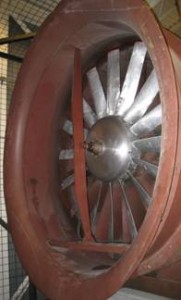Boundary Layer Wind Tunnel

The Boundary Layer Wind Tunnel (BLWT) is an open-circuit wind tunnel approximately 30m in length. It is used primarily for boundary layer, architectural, and wind-engineering studies, as well as fundamental work. In the past the BLWT has been used to model the aerodynamics of sports equipment, forest clear-cutting patterns, marine propellers, submarines, and local Vancouver landmarks BC Place and the Provincial Law Courts.
Tunnel specifications:
- Test Section: 1.6m high by 2.5m wide, 23.6m long
- Speed Range: 3m/s- 20m/s
Parkinson Wind Tunnel
The Parkinson Wind Tunnel is a closed-circuit wind tunnel approximately 13m in length. It is used primarily for aeronautical research and fundamental studies of flow-induced oscillations as well as studies of wind tunnel blockage effects.
Tunnel specifications:
- Test Section: 0.7m high by 1.0m wide, 2.6m long
- Speed Range: 5m/s to 35m/s
Flow Visualizations

Helium bubble and yarn tuft visualizations are the most common techniques used at our facilities. For helium bubble visualizations, our facilities operate a Model 5 Sage Action Inc. Helium Bubble Generator. Upon request, our facilities are also capable of smoke and surface oil visualizations.
Force Balance
A specially designed two-axis, air-bearing force balance is mounted below each wind tunnel and measures side and drag forces. Data acquisition is performed using a 16 channel IOtech board.
Specifications:
- Maximum measurable side load: 250N in the presence of 2200N vertical load
- Maximum measurable drag load: 250N in the presence of 2200N vertical load
- Accuracy: better then 0.3% full scale, independent of vertical load
A technical paper describing the force balance is located here.